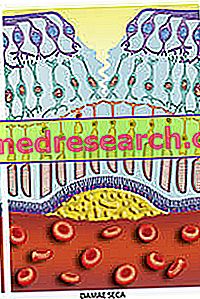Generality
The drusen are deposits of protein-lipid material, of yellow or white color, which form under the retina.

Figure : a drusen between retinal pigment epithelium and Bruch's membrane.
The exact position is between the retinal pigment epithelium (last layer of the retina) and the so-called Bruch membrane (innermost portion of the choroid).
As a result of the aging process, drusen can be of two types: rigid or soft. Rigid drusen are usually asymptomatic, while soft drusen are generally associated with an ocular morbid condition, typical of old age, called dry senile macular degeneration.
The drusen are identified with a simple examination of the ocular fundus.
The treatments depend on the type of drusen: for rigid ones, no particular therapy is provided; for soft ones, however, it is useful to adopt the treatment methods provided for dry senile macular degeneration.
Short review of the anatomy of the eye
In the eye (or eyeball ), located in the orbital cavity, three concentric portions can be identified, which, from the outside towards the inside, are:
- The external habit . Area in which cornea and sclera reside, acts as an attack for the so-called extrinsic muscles of the eyeball.
It has a fibrous nature.
- The medium tunic (or uvea ). It is a membrane of connective tissue, rich in blood vessels and pigment.
Interposed between sclera and retina, it deals with providing nourishment to the retina, or rather to the layers of retina with which it comes into contact.
Includes iris, ciliary body and choroid.
- The internal habit . It consists of the retina; the latter is a transparent film, formed by ten layers of nerve cells (or neurons) and with the task of converting light into an electrical signal decipherable by the brain.
The main nerve cells of the retina, which deal with visual function, are the cones and rods. Cones and rods are generally called photoreceptors.

What are drusen?
The drusen are yellow or white deposits, consisting mainly of protein-lipid material, which form under the retina, exactly between the retinal pigment epithelium and the Bruch membrane .
Their notoriety is due to the fact that they characterize a widespread morbid condition of the eye, called dry senile macular degeneration .

TYPES OF DRUSEN
There are at least two types of drusen: the rigid type (in English, hard ) and the soft type (in English, soft ).
Rigid drusens have small dimensions, are arranged far apart from one another and are generally not connected to any eye problems.
The soft drusen, on the other hand, are large deposits (larger than the rigid drusen), often arranged next to each other, with poorly defined edges and usually found in people suffering from dry senile macular degeneration.
UNDERSTAND THE PRECISE DRUSEN POSITION
Located in close contact with each other, the retinal pigment epithelium and the Bruch membrane are, respectively, the last layer of cells of the retina and the innermost cellular portion of the choroid.
The retinal pigment epithelium consists of a monolayer of pigmented cells (this is where the name comes from), which cover various functions. One of these functions is to supply the retinal cells with blood and nutrients (from the choroid).
Above the retinal pigment epithelium cones and rods take place.
The Bruch membrane is a kind of very thin 2-4 micrometer sheet, formed by two basement membranes (one on the side of the choroid and one on the side of the retinal pigment epithelium), collagen fibers and elastic fibers.
Through the Bruch membrane and in the direction of the choroid, the metabolic waste products pass, previously eliminated by the cells of the retinal pigment epithelium.
MACULAR DEGENERATION
In medicine, macular degeneration is defined as a group of ocular pathologies, characterized by a deterioration of the macula - or the central area of the retina - and a progressive loss of vision.
The most known and widespread form of macular degeneration is the so-called age-related macular degeneration (or age-related macular degeneration or AMD ). This condition is typical of elderly people (over 60 years) and should be considered as one of the possible consequences of the normal aging process.
After years of research, experts in ocular diseases have discovered that there are two types of age-related macular degeneration:
- Wet (or exudative ) age-related macular degeneration . Damage to the macula is caused by the leakage of liquids and blood from some blood vessels, formed in a completely anomalous way starting from the choroid and in the direction of the macula itself. Liquids and blood coming out of deposit under the macula, which consequently rises and deforms.
Of the two forms of macular degeneration, it is the most serious, because it can quickly affect the central vision (the latter function, which belongs to the macula).
Fortunately, it is infrequent. In fact, it represents only 10% of cases of macular degeneration.
- Dry senile macular degeneration . Deterioration of the macula begins when so-called soft drusens make their appearance. In fact, starting from this moment, the central area of the retina begins to thin, causing a gradual darkening of the sight and other visual disturbances. Over time, the thinning of the macula is followed by its atrophy and then the death of its constituent cells.
In some situations, dry senile macular degeneration can turn into a wet form.
Juvenile macular degeneration: macular dystrophy
Another form of macular degeneration is the so-called juvenile macular degeneration or macular dystrophy .
This rare morbid condition affects - as can be guessed by the name - children and young adults and arises due to a genetic mutation, often transmitted by inheritance.
Similarly to AMD, there are various types of macular dystrophy: Stargardt's disease, vitelliform macular dystrophy and macular dystrophy of North Carolina.
Among these three types, the one in which drusen can be found under the retina is the macular dystrophy of North Carolina.
The presence of these protein-lipid deposits is variable and not if the causes and relations with the disease are still understood.
DRUSEN OF THE OPTICAL NERVE
The drusen of the optic nerve are different from the drusen that reside between the retina and the choroid.
First of all, they consist of a protein material mixed with calcium salts; secondly, they can be found very often even in children; finally, they are generally not linked to any particular visual disturbance.
Please note . For the avoidance of doubt in this article, with the word "drusen" only reference is made to the drusen present between retinal pigment epithelium and Bruch's membrane.
Causes
The drusen appear with aging.
According to the most recent and reliable theories, they would be formed because, over time, the retinal ocular cells (and not only) become less and less effective in eliminating waste products.
DRUSEN AND MACULAR SENILE DRY DEGENERATION
Despite numerous studies in this regard, the researchers have not yet identified the precise link between dry senile macular degeneration and the presence of drusen (a sign that doctors consider characteristic of the aforementioned ocular pathology).
The doubts are basically two: "are the drusen causing the disease?" or "do drusen and age-related macular degeneration appear due to another process (not yet identified)?"
According to the latest findings, the most plausible hypothesis holds that drusen would induce the deterioration of macula cells, because with their presence they would deprive the retinal pigment epithelium and the photoreceptors of the nutrients and oxygen they need.
RISK FACTORS AND EPIDEMIOLOGY
In general, drusen begin to make their first appearance around the age of 40.
In people 60 or older, they are very common presences, so they can be considered typical of old age.
According to the most recent statistical research, the most interested breed would be the Caucasian one. Not by chance, the Caucasian race is also the one that most frequently develops senile (dry and wet) macular degeneration.
At the moment, scholars are trying to understand if some factors favoring age-related macular degeneration - including family predisposition, cigarette smoking and high levels of cholesterol in the blood - are also risk factors for the appearance of drusen.
As regards the drusen of the optic nerve, it has been noted that their presence is associated with a certain family predisposition and, as in the case of the drusen between retina and choroid, it is more widespread among Caucasian people.
Symptoms and Complications
In most cases, the drusen are of the rigid type and these, as will be remembered, do not generally determine any particular symptomatology.
When instead the presence of soft drusen is linked to dry senile macular degeneration, people with this eye condition complain:
- Central vision blurred and / or distorted .
- Presence of a blind spot in the visual field. Over time, the blind spot becomes bigger and bigger, to the point of making everyday activities such as reading, driving a vehicle, etc. extremely difficult.
- Decreased visual acuity.
- Inability to grasp the details of an object or to recognize the face of the people observed.
- View of one or more black spots in the center of the visual field.
- Difficulty seeing in bright environments ( photophobia ).
- Need an ever brighter light source to see up close.
- Difficulty of adaptation when passing from darkness to light.
Complications of dry senile macular degeneration
If left untreated, dry age-related macular degeneration (as well as wet) can severely affect a person's visual abilities. However, it almost never causes complete blindness, as the eye structures responsible for peripheral vision are not altered.

POSSIBLE SYMPTOMS IN CASE OF DRUSEN OF THE OPTICAL NERVE
The drusen of the optic nerve can be considered as usually asymptomatic presences.
In those rare cases in which they cause visual disturbances, these consist of: loss of peripheral vision, flickering vision and altered perception of white and gray.
COMPLICATIONS
Rigid drusen - therefore asymptomatic - can suddenly and for unknown reasons turn into soft drusen; this coincides with a deterioration of the macula and the appearance of visual problems.
Diagnosis
Ophthalmologists identify the presence of drusen through an accurate examination of the ocular fundus .
They use a special instrument - the so-called ophthalmoscope - that allows the vision of the internal structures of the eyeball, such as the retina and its central area (ie the macula).
To get as much information as possible, you should usually administer an eye drop that dilates the pupil. This preparation works within 30 minutes and ends its effects after a maximum of 6 hours. During this time, it is strongly advised against driving a vehicle, for one's own safety and for other road users.
DIAGNOSIS OF DRUSEN AND MACULAR DEGENERATION
The identification of soft drusen, in an individual with clear symptoms of AMD, is information of considerable interest and very indicative, as it means dry age-related macular degeneration.
In these situations, once the examination of the fundus has been completed, ophthalmologists submit the patient to the so-called Amsler grid test, one of the simplest and most effective assessments to analyze the state of health of the macula.
Amsler grid test
The Amsler grid is a pattern of intersecting straight lines (reminiscent of a playing field for naval battle), with a black dot in the middle.
The test consists in observing, with one eye at a time, the central black point, at a distance of about 12-15 centimeters.
If the observer has a normal vision, all the lines around the black point appear straight, without anomalies and with normal spacing between one and the other.
If instead the observer perceives the lines as distorted, bent and / or missing, it is highly probable that the cause of the aforementioned anomalies is a problem of the macula.
Treatment
Rigid drusen do not require any special treatment. In these situations, the only indication of the doctor is to undergo periodic eye checks, in such a way as to identify in time a possible transformation into soft drusen.
As for dry macular macular degeneration and the presence of soft drusen, there are no real methods of treatment, but rather symptomatic remedies, or aimed at reducing symptoms. These symptomatic remedies consist of:
- Intake of particular food nutrients, called AREDS 2 and containing vitamin C, vitamin E, lutein, zeaxanthin, zinc oxide and cupric oxide. Based on the studies conducted in this regard, these preparations would seem to slow the progression of the disease.
- Antioxidant intake.
- Avoid exposure to UV rays as much as possible . It seems that the ultraviolet rays of the sun are factors favoring the appearance of macular degeneration.
- Adopt a healthy diet .
ELIMINATE DRUSEN IS USEFUL?
Based on the experiments conducted, eliminating soft drusen would not heal (or even improve) the condition of macular degeneration present.
DRUSEN OF THE OPTICAL NERVE
For optic nerve drusen, no treatment is expected.
Even in these circumstances, the only indication of the doctor is to undergo regular eye examinations, in order to identify any worsening of the situation promptly.
Prognosis
Prognosis in the case of rigid drusen is generally positive.
In contrast, the prognosis for subjects with soft drusen depends on the severity of age-related macular degeneration.



